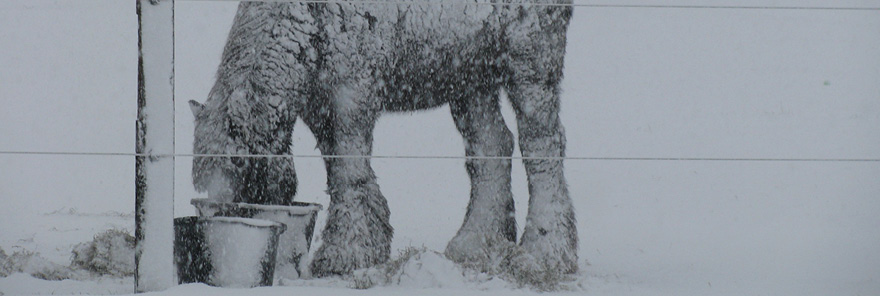Frozen water buckets: they can affect your life almost anywhere in the United States. Even in the warmest winter refuges of Florida, a freeze can sweep over your farm and harden your horse’s water buckets or trough to a solid mass overnight, leaving your horse without water, and you with the unpleasant task of breaking all that ice. In extreme climates, when the air temperature drops well below zero for extended periods of time, it can be hard to get by without purpose made bucket warmers. For those times when it isn’t an arctic blast, however, you might be able to reduce your energy consumption, reaping benefits for both the planet and your pocketbook. Below, we have some tips on how to keep your horse’s water from freezing this winter.
Insulated buckets: This might be the most obvious, but stick with us for a moment. Insulated water buckets aren’t the cheapest thing: they can cost upwards of $75 for just one five-gallon bucket. However, if your barn is particularly cold and your other option is an electric bucket warmer, consider the savings in electricity. One bucket heater could cost you as much as $3 per day. Multiply that by all your buckets in all your stalls, and you’ll be ordering those insulated buckets by next-day air.
Solar-heated water troughs: Did you know you can DIY an insulated pasture trough which stays ice-free all winter? It sounds complicated, but it actually just requires some basic materials from your home improvement store and a basic comfort level with some power tools. Mother Earth News offer these instructions for a solar stock tank which utilizes the sun to heat water, insulating double walls to keep heat in overnight, and a relatively small drinking space to minimize heat loss from the water’s surface. It’s all built around a regular water trough — the kind you probably already have in your pasture. Get the details at Mother Earth News.
Toys for troughs: If a thin layer of ice is your biggest risk, a half-inflated horse ball can be your best friend. The rubber ball keeps the water moving in strong breezes, preventing ice from forming. If a layer of ice does form, all your horse has to do is push on the ball with his nose to reach fresh water. If your horse can figure out how to use the float on an automatic waterer to make the bowl refill, he can probably learn to use the floating ball on the water trough in the same way.
Heat up the cooler: A big water cooler, like the ones you see on construction sites, can actually double as a water bucket with the lid removed. If you have a particularly cold pasture with a persistently freezing water trough, try placing a cooler like this in a sunny spot. Prime the cooler with hot water in the morning and let it sit until the cooler’s insulating interior is warmed up, (much like a barista will fill a coffee carafe with hot water before pouring in the day’s coffee), and the inside of the cooler will stay warm much longer than if you just fill it with cold water from the hose.
Ice is an unfortunate fact of life with horses in cold climates. Whether you live in an area that receives an occasional cold front, or your farm is routinely plunged into a deep freeze, there are ways to reduce your dependence on electric bucket warmers and still provide ice-free drinking water to your horses. What are some of your favorite ways to keep your buckets and troughs ice-free?


